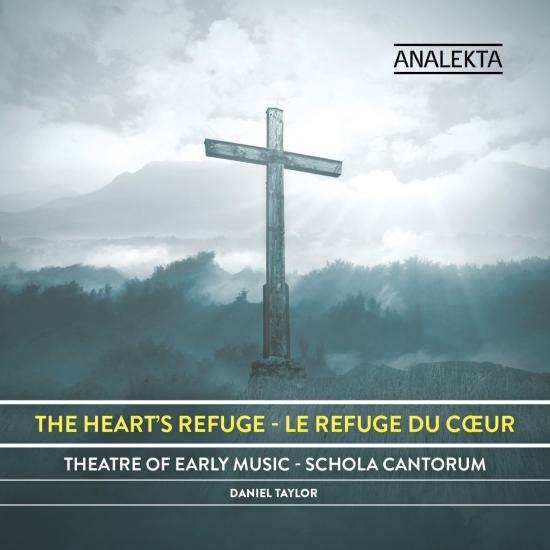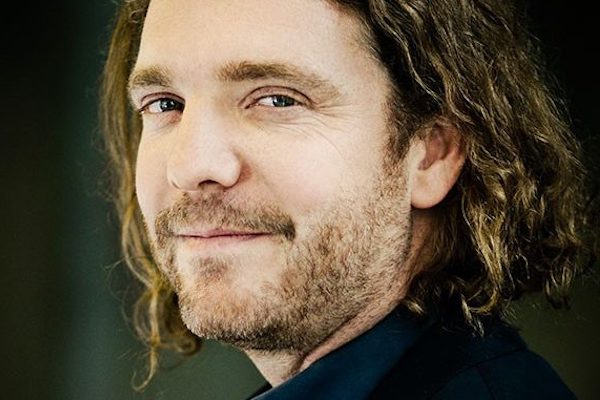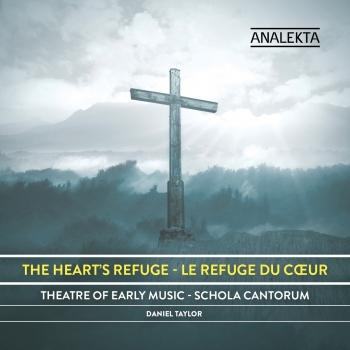
The Heart's Refuge Theatre of Early Music, Schola Cantorum & Daniel Taylor
Album info
Album-Release:
2014
HRA-Release:
28.11.2019
Label: Groupe Analekta, Inc
Genre: Classical
Subgenre: Vocal
Artist: Theatre of Early Music, Schola Cantorum & Daniel Taylor
Album including Album cover
- Dietrich Buxtehude (1637 - 1707):
- 1Jesu, meines Lebens Leben, BuxWV 6208:15
- Johann Christoph Bach (1642 - 1703):
- 2Es ist nun aus mit menem Leben07:25
- Johann Heinrich Schmelzer (1623 - 1680):
- 3Harmonia a cinque con basso continuo in B-Flat Major05:59
- Johann Kuhnau (1660 - 1722): Gott, sei mir gnädig nach diener Güte:
- 4Gott, sei mir gnädig nach diener Güte: Gott, sei mir gnädig nach deiner Güte02:45
- 5Gott, sei mir gnädig nach diener Güte: Wasche mich wohl von meiner Missetat01:28
- 6Gott, sei mir gnädig nach diener Güte: Denn ich erkenne meine Missetat00:29
- 7Gott, sei mir gnädig nach diener Güte: An dir allein hab' ich gesündiget02:08
- 8Gott, sei mir gnädig nach diener Güte: Siehe, ich bin aus sündlichem Samen gezeuget02:02
- 9Gott, sei mir gnädig nach diener Güte: Entsündige mich mit Isopen01:15
- 10Gott, sei mir gnädig nach diener Güte: Lass mich hören Freud und Wonne02:59
- Nicolaus Bruhns (1665 - 1697): Ich liege und schlafe mit Frieden:
- 11Ich liege und schlafe mit Frieden: Ich liege und schlafe03:30
- 12Ich liege und schlafe mit Frieden: Aria. Ich hab, Gottlob, das mein vollbracht01:54
- 13Ich liege und schlafe mit Frieden: Ritornello00:38
- 14Ich liege und schlafe mit Frieden: In Jesu Namen schlaf ich ein01:55
- 15Ich liege und schlafe mit Frieden: Ritornello00:38
- 16Ich liege und schlafe mit Frieden: Aria. In Jesu Namen fahr ich hin02:02
- 17Ich liege und schlafe mit Frieden: Ich liege und schlafe03:40
Info for The Heart's Refuge
To people so oppressed, music simultaneously brought comfort, indispensable earthly pleasure, and the spiritual elevation to which they aspired.
It was primarily thanks to music that the German-speaking countries were able to recover from the ordeal of the Thirty Years’ War. When this conflict finally ended, in 1648, their numbers had been cut in half. Continuing intimate contact with death and disaster gave more weight than ever to the Christian message: renounce life with all its vicissitudes, and hope for eternal happiness in the beyond. The art that most benefitted from this development was music; and because of the importance Luther accorded to the art of sound, this was particularly so amongst the Lutherans. Thus Johann Sebastian Bach arose as the heir to a rich tradition involving music and the concept of death as deliverance.
During the 17th century, Lutheran musicians produced a magnificent repertoire of sacred music. To do so, they borrowed forms developed and constantly refreshed by Italians, the first masters of Baroque music. German composers, however, adapted what they borrowed to their own language and outlook, carefully giving their works quite unique qualities of harmony, contrapuntal density, variety of form, and expressive power. Apart from a few rare Latin texts, the librettos of these works are in German. They are drawn, very freely, from the Bible, or from paraphrases or poetic commentaries written by pastors or theologians. Their subjects, sometimes illustrated by ingenious musical images, are: the confusion of the soul in a state of sin; the confident assurance of encountering Jesus in death, often associated with sleep; and the discord between this ‘vale of tears’ and eternal bliss praising and giving thanks to God.
Though the term ‘cantata’ seems normal to us, the German masters of the time, including Bach, rarely used it to designate their sacred vocal compositions. Only from 1710 on did church musicians adopt the model of the Italian secular cantata, with its succession of recitatives and da capo arias. Depending on the texts they were setting to music or their compositional techniques, they used names such as concerto, motetto, aria, dialogo, or Kirchenmusik to designate their works. Among these compositional techniques we find, sometimes in the same work, distinctive choral polyphony of the motet, accompanied monody, arioso, strophic air with ritornello, and ensembles of instruments and voices arranged in the most ingenious concertant style.
As well as the basso continuo, the accompaniment to these works was often for five voices: that is, for one or two violins with two or three inner voices assigned to violas or viols. Such a distribution gave to the works a dark coloration in keeping with their subjects. When instruments were called for they played essential roles, engaging in dialogue with the singers, commenting or amplifying their melodic motives, suggestively illustrating in musical terms certain words of the text, and clearly marking the end of sections of the work with ritornellos.
The new expressive role played by instruments in this period is particularly clear in a piece attributed to Johann Heinrich Schmelzer and entitled Harmonia a 5. It is scored for a solo violin accompanied, in very harmonic fashion and with surprising chromaticisms, by a second violin, two violas, and the basso continuo. This work is, in fact, a real instrumental aria; the soloist unfurls a melody that is quite vocal in nature, but with, in places, very rapid, violinistic passages, and thus anticipates, by a few decades, the concerto.
Dietrich Buxtehude, who spent his entire life as organist at the Marienkirche in Lübeck, left a major body of sacred works. His Jesu, meines Lebens Leben (Jesus, life of my life), a stropic aria for four voices, is a setting of a text by Ernst Christoph Hombourg that was included in the hymnal Geistliche Lieder (Sacred Songs), published in 1659. The aria is built on a ground bass; it is as if the inexorably repeated motif is intended to hammer home in the believer’s mind its message: meditate on the sufferings of Christ and on what they mean, on atonement for sin and attainment of eternal life. After a short instrumental introduction, the voices combine freely, and each of the verses ends with the same expression of gratitude.
The most illustrious of Johann Sebastian Bach’s musical ancestors was his father’s cousin, Johann Christoph Bach. His strophic aria Es ist nun aus mit meinem Leben (Now my life is ended), a setting of a text whose author remains unknown, is written for four voices. By using very spare melodies and refined harmonies, he created, in this work, a profound feeling of peace. Of particular note is the soprano’s leap of a ninth on the words Welt, gute Nacht (Good Night, World) at the end of each verse, illustrating the farewell to which the believer aspires.
Though it is almost impossible to date most of this repertoire, we are fairly sure that Johann Kuhnau wrote his cantata Gott, sei mir gnädig nach diener Güte (God, be gracious to me in your goodness) in 1705. A setting of several verses of Psalm 50 (Miserere), the work is conceived as a cantata divided into separate sections. For the sake of contrast, choruses — sometimes syllabic, sometimes fugal — follow each other in rapid succession, along with airs that have little development — they are often close to ariosos in form — while the orchestra repeats the motifs of the vocal parts.
Nicolaus Bruhns, Buxtehude’s most gifted student, died at the age of 32. His cantata Ich liege und schlafe mit Frieden (I am laying and sleeping in peace) also evokes the desire for death and for deliverance from earthly suffering. It begins with a verse from Psalm 4, and then uses a funerary text written by Georg Werner and published in 1639. After a Sinfonia and a first chorus, both very similar to those of Bach’s Cantata BWV 21 and in the same key of C minor, the succession of voices, from the soprano to the bass, suggests the descent into the tomb. Blending assertive turns of rhythm with expressive silences and counterpoint, the work also includes several madrigalisms, such as the ornaments on fröhlich (joyous) and Freud (joy) in the duo for alto and tenor.
These works, like many others, are the product of profoundly religious thought. Today, however, whether we are believers or not, we can appreciate them for their inherent qualities. Bach’s predecessors created music that was totally original, sophisticated, as free in form as it was varied, and powerfully expressive.
Schola Cantorum
Theatre of Early Music
Daniel Taylor, countertenor, direction


Theatre of Early Music
Founded by artistic director and conductor Daniel Taylor, the Theatre of Early Music (TEM) are sought-after interpreters of magnificent yet neglected choral repertoire from four centuries. Their appearances include stunning a cappella programs, with practices and aesthetics of former ages informing thought-provoking, passionate and committed reconstructions of music for historical events and major works from the oratorio tradition. Through their concert performances and recordings, the 10-18 solo singers offer a purity and clarity in their sound which has resulted in invitations from an ever-widening circle of the world’s leading stages. With Daniel Taylor, the Choir and Orchestra of the TEM are new visitors to the most renowned concert halls and festivals and are building an exciting discography.
The Theatre of Early Music is an ensemble of some of the world’s finest musicians, sharing a particular passion for early music. Its formation is the result of a search by instrumentalists and singers for opportunities that would allow devotion and dedication to enter into the creative process. The core of the TEM consists of an ensemble based in Canada that is primarily made up of young soloists. Their distinctive style, coupled with artistic director Daniel Taylor’s expertise and enthusiasm, leads to captivating readings of magnificent but often neglected works. In various combinations, leading international musicians in the field perform on the platform provided by the Theatre of Early Music in concerts conducted by Daniel Taylor in its regular series in Montreal, Ottawa and Toronto, on tours around the world and on recordings. The TEM appear in some thirty concerts every year, recently having performed on stages in France, Argentina, Brazil, England and China. Most recently, the TEM led a successful North American tours that culminated with their debut at New York’s famous Carnegie Hall. The calendar also included collaborations with Dame Emma Kirkby, concerts of Handel’s Coronation Anthems and ancient German music, as well as tours of Canada, the United States and South America.
Guest artists performing with the TEM include Nancy Argenta, Robin Blaze, James Bowman, Benjamin Butterfield, Michael Chance, Charles Daniels, Neal Davies, Alexander Dobson, Karina Gauvin, Michael George, James Gilchrist, Peter Harvey, Dame Emma Kirkby, Suzie Leblanc, Daniel Lichti, Carolyn Sampson, Michiel Schrey, Stephen Varcoe, Deborah York and Agnes Zsigovics.
The Choir and Orchestra of the Theatre of Early Music has released a dozen albums so far. The best-selling debut album The Voice of Bach was praised in Gramophone Magazine as “serious music-making of the highest order”. The disc received five stars from both BBC Music Magazine and Classic Music CD, was featured on BBC’s “Desert Island Discs” and received acclaim worldwide including reviews from the Times (London), the Globe and Mail (Toronto), the New York Times, the Guardian (London) and La Scena Musicale (Montreal).
Come Again Sweet Love was also very well received by the leading media critics, as was their 2014 album The Heart’s Refuge, which reached #1 on the Canadian classical music chart.
Schola Cantorum (University of Toronto)
Founded in 2012 by Daniel Taylor, the University of Toronto Schola Cantorum aims to present the brilliant early choral and instrumental repertoire from across the centuries to a new audience. The group’s interpretations strive to recreate the original performances of musical works – interpretations led by the energy and insights of the gifted students themselves – in the belief that historical performance ideals and knowledge of the old world are essential for creating music anew. The Schola Cantorum includes students from all levels of study (Bachelor in Music, Master in Music and Doctoral Candidates), with students representing many voice studios in the Faculty. Canada has many university choral ensembles, however the Schola Cantorum is the only large scale group using period instruments and historically informed performance practices to reveal the beauty of baroque and early repertoire.
In 2012-2013, the Schola Cantorum made its inaugural performance with the famed Tallis Scholars. The ensemble also performed and toured central Canada presenting Handel’s Coronation Anthems and recorded early German works including Buxtehude’s Jesu meines Lebens Leben. In 2013-2014, the ensemble appeared in concert touring with the Gabrieli Consort, presented Purcell’s Dido and Aeneas to on four evenings to capacity audiences and offered a reenactment of the coronation ceremony of King George II (also sold-out). Most recently, the group presented Heinrich Schütz’s three-movement Musikalische Exequien in concert, accompanied by the Theatre of Early Music Orchestra.
The University of Toronto Faculty of Music is located in one of the world’s most vibrant, multicultural, arts-oriented cities. Based on publications and citations, the University of Toronto leads Canadian research universities in Fine Arts and Music.
Daniel Taylor
is one of the most sought-after countertenors in the world. He appears on more than 100 recordings. Mr. Taylor has performed with the New York Metropolitan Opera, Glyndebourne, Rome, San Francisco, Welsh National, Montreal, and Canadian Opera; at the Edinburgh Festival and at the Royal Albert Hall/BBC Proms. He recently took a role in the world premiere of the Robert Lepage staging of Thomas Adès’s The Tempest. He works with the Tonhalle Zurich, Toronto, Gothenburg, Rotterdam, St. Louis, and Cleveland orchestras. In recital, he has sung at Wigmore Hall, Carnegie Hall, in Beijing, Barcelona, and across North America. He sang on Parliament Hill for Queen Elizabeth and the Prime Minister of Canada.
Mr. Taylor is a professor of voice and opera and head of Historical Performance at the University of Toronto, visiting faculty at the Victoria Conservatory of Music, and a visiting artist at the University of Vienna. He is artistic director and conductor of the choir and orchestra of the Theatre of Early Music, which performs more than 30 concerts every year in concert halls all over the world. He is also artistic director of the new professional ensemble The Trinity Choir, whose second critically acclaimed recording The Tree of Life was released in 2016. Having recently turned his attention to conducting, he was the first guest conductor in the history of the Tallis Scholars. He has also made his debuts with the Kammerchor Stuttgart and the Gabrieli Consort. In 2013, Prof. Taylor was awarded the Queen’s Diamond Jubilee Medal by the Governor General for his work in charity and cultural development in Canada. His recent recording with actor Jeremy Irons won a Grammy.
This album contains no booklet.







